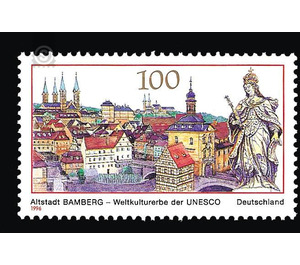Cultural and natural heritage of humanity - Germany / Federal Republic of Germany 1996 - 100 Pfennig
Theme: Architecture
| Country | Germany / Federal Republic of Germany |
| Issue Date | 1996 |
| Face Value | 100.00 |
| Color | multi-colored white |
| Perforation | K 14 |
| Printing Type | Multicolor offset printing |
| Stamp Type | Postage stamp |
| Item Type | Stamp |
| Chronological Issue Number | 1754 |
| Chronological Chapter | GER-BRD |
| SID | 618389 |
| In 35 Wishlists | |
»The Old Town of Bamberg uniquely represents the Central European city, which was developed on an early medieval basis. The "Franconian Rome" on the Regnitz forms a city ensemble of the highest rarity, "said Dr. Bernd Freiherr von Droste zu Hülshoff, Director of the UNESCO World Heritage Center in Paris, on the occasion of Bamberg's inclusion in the World Heritage List in 1993/94. 902 Bamberg was first mentioned in a document; its early glory experienced it under emperor Heinrich II. (1002-1024), who had the first cathedral built on the place of an existing castle. Heinrich not only made his Bamberg a bishopric, but also his favorite place of residence and government. Before Bamberg came to Bavaria at the beginning of the 19th century as part of the secularization, the city was a small state governed by a prince-bishop. With the help of Balthasar Neumann, the Dientzenhofer brothers and other prominent architects, the prince-bishops of Schönborn had an imposing building after the other built or converted in the 18th century, from magnificent churches and palaces to the most magnificent town houses of the "island city". One of the main attractions is the 1237 consecrated Imperial Cathedral, one of the most outstanding church buildings of the Middle Ages. The cathedral houses the »Bamberger Reiter«, a sculpture probably made around 1235, which is considered a »landmark of German art«. Bamberg is despite the »monumental character« a city filled with vibrant life. (Text: City of Bamberg)


